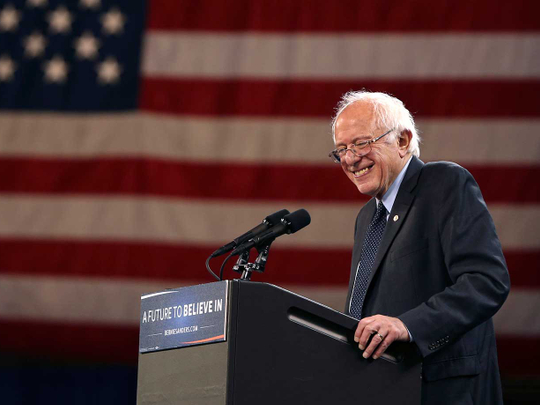
Because so much attention has been focused on the anger and dysfunction gripping America’s Republican Party, it is worth pausing for a moment to take a closer look at the Democrats.
The contest between former Secretary of State Hillary Clinton and Senator Bernie Sanders of Vermont is closer, and has gone on longer, than anyone — including Sanders himself — would have predicted six months ago. But to say that the Democratic Party is experiencing the same sort of existential struggle as the Republicans is to misunderstand what is happening on America’s political left and its implications for November’s general election. Simply put, the Democratic Party is not in the process of tearing itself apart.
The most common themes one hears when this subject comes up are that the party is deeply, perhaps irreparably, split; that a contested convention is a real possibility this summer and that if Sanders fails to win the nomination many, perhaps most, of his supporters will refuse to support Clinton in the autumn. Let’s take these points one-by-one.
No one would deny that the divide between the Sanders and Clinton camps runs deep, but to compare it to the fractures currently tearing apart the Republicans is a false equivalence. The Republicans are trying to cope with the split between an angry nativist base that wants to deport 11 million people and bar Muslims from the country and a party establishment whose main concerns are cutting taxes on the rich and repealing business regulations.
Many Sanders and Trump supporters share a belief that American politics is rigged in favour of the rich. The difference between them is that this belief fundamentally contradicts basic Republican doctrines (cynics will say that Republicans accept this analysis but just don’t think it is a problem), but, ideologically speaking, is broadly accepted among Democrats.
Republicans tend to assume that people who fall behind economically do so because of their own lack of initiative and believe that the best thing government can do is to lower taxes and roll back regulations. (just last week new rules went into effect in the US requiring personal financial planners to offer advice that is in their client’s best interests — the new rule was fought tooth and nail on behalf of the banking industry by Congressional Republicans).
When it comes to big companies and bigger banks, Clinton and Sanders differ over how much and what sort of regulation should be enforced, but agree that government action is necessary to protect ordinary Americans from the sort of rapacious capitalism that Republicans often celebrate. Many of the people voting for Trump believe they need protection from the banks, and that their party’s establishment is not listening to them. In contrast, the debate on the left is not whether to regulate the financial industry but how heavily to do so.
Clinton comfortably on track
That brings us to a contested convention. Regular readers will know that I often warn that these are the unicorns of American politics: often discussed, never seen. The last time a presidential nominating vote in either party went to a second ballot was 1952. Every four years journalists salivate at the thought of an “open” or “contested” convention, but it never happens.
It now appears that on the Republican side this may, indeed, be the year of the unicorn, but the idea that the Democrats, too, are headed toward an open fight for the presidential nomination is just as fictitious today as it was four, eight or 20 years ago. Last Saturday Sanders beat Clinton decisively in caucuses in the western state of Wyoming. It was his eighth win in the last nine state nominating contests. Despite winning by 11 points, however, because of the complex rules under which convention delegates are selected, he and Clinton ended up tied, meaning the victory did nothing to close the commanding lead Clinton still enjoys in delegates. Breathless media commentary to the contrary, Clinton remains comfortably on track to claim the nomination on the first ballot at July’s Democratic National Convention.
That leaves us with the autumn campaign. The idea that Democrats supporting Sanders will angrily leave the party if he does not win the nomination, thereby fatally undercutting Clinton’s candidacy, has been repeated so many times in recent weeks that it has taken on an aura of obvious inevitability. Many of the pundits promoting this idea, however, seem to forget the last candidate about whom it became conventional wisdom: Hillary Clinton in 2008.
Back then we were told that the middle-aged and older women who were her most ardent supporters would never back Barack Obama. They would stay home in November, denying him crucial votes in swing states. Some might even vote for the Republicans (one can argue that John McCain’s disastrous choice of Sarah Palin as his running mate was, in part, an effort to capitalise on this sentiment). Need I remind anyone how that worked out?
This year will be no different. Regardless of what they may say now, when faced with the prospect of putting Donald Trump or Texas Senator Ted Cruz into the White House, Democrats across the board will back Clinton just as, eight years ago, they came together for Obama.
This is not to say that Clinton has the autumn campaign locked up. There are many months, and many twists and turns, still to come. It is far too early to say who will be America’s next president. But in comparing the present state of Republicans and Democrats let’s not fall victim to false comparisons: only one of America’s two political parties is in the process of tearing itself apart.
Gordon Robison, a longtime Middle East journalist and US political analyst, teaches political science at the University of Vermont.










